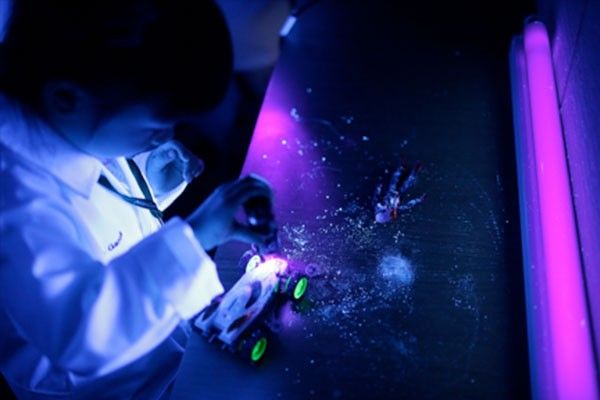Let’s talk about germs, baby!


What you don’t know won’t hurt you — it could kill you.
I’m referring to the dirt that the naked eye can’t see — germs, not your husband’s lover, silly!
Wherever you go, bacteria abound. They live on surfaces and spread to humans through skin contact. The most alarming part is many of these disease-causing bacteria lurk in our homes.
The kitchen happens to be one of the filthiest rooms in the house, mostly due to the moisture from the sink, which breeds bacteria.
Did you know that your kitchen sink contains 100,000 times more germs than your toilet? That’s because food (which could be contaminated by dangerous organisms like salmonella and E.coli) often gets trapped in your sink drain.
Sponges harbor lots of germs, also dish towels, and there are lots of nooks and crannies for them to hide in. If your dish towels get soaked, you should wash them after every use in hot water. As for the sponge, pop it in the microwave on high for one minute every three to five days to rid them of bacteria.
The TV remote control and your mobile phone, just like the toilet bowl, are also incredibly germ-infested!
So, what’s a clean freak to do? How can we protect our family from all those germs lying around?
“Protection from germ threats begin with proper hand washing and bathing,” notes Ronaldo Puno, president of the Philippine Association of Medical Technologists Inc. (PAMET), during Procter & Gamble’s Science and Discovery Tour held recently at the P&G Innovation Centre in Singapore.
Hosted by Safeguard, the main objective of the event was to educate moms and kids on how certain types of bacteria could pose a major health threat, how germs spread, and how to protect ourselves from these invisible enemies.
Germs, Germs Everywhere
Prior to our Singapore trip, the P&G team, together with PAMET president Ronaldo Puno and vice president Luella Vertucio, visited the homes of select mom bloggers to collect swab samples from the toys and electronic devices their kids use so they could study the germs, then forwarded the findings to P&G’s state-of-the-art lab in Singapore in time for our visit.
“A lot of the microorganisms found in your homes are from the Staphylococcus family,” explains Angelina Caranza, section head, Global Microbiology Capability Organization Research & Development, Procter & Gamble international operations, “You can get this type of bacteria from contaminated surfaces and skin-to-skin contact. Staphylococcus causes skin infections, impetigo (red sores), and body odor.”
According to Caranza, bacteria are a type of germ. “Germ is the general term for the different types of bacteria. It is the layman’s term for microorganisms.”
Caranza and her team also “grew” other types of microorganisms found in kids’ toys and toothbrushes.
“Majority of the bacteria found are of fecal origin, which means they are present in the intestines. One good example is the Klebsiella, which is the leading cause of hospital-based infections for infants. Infants have a relatively weak immune system so you could imagine their risk factor,” Carranza explained.
E.coli is also of fecal origin and could cause diarrhea. These microorganisms, although fecal in origin, can be found in objects like toothbrushes and other objects kids play with.
“So always make sure that the kids wash their hands before and after playing,” Caranza warned.
Handy Advice On Raw Food
For moms who love to cook, Caranza cautioned them on proper food handling, especially raw chicken.
“You may have your own recipe of chicken adobo. Well, do you have an idea how much bacteria you get exposed to just by holding raw chicken? A lot! So, if you don’t wash your hands after touching the chicken, you could be spreading salmonella in your home. Salmonella causes diarrhea, fever, and abdominal pain,” Caranza added.
As PAMET president Ronaldo Puno mentioned, protection from germ threats begins with proper hand washing and bathing.
“It is imperative for all members of the household, especially children, to use an effective anti-bacterial soap that can kill these germs effectively and prevent their regrowth,” noted Puno.
For over 50 years in the Philippines, Safeguard has been recommended by leading health experts for germ protection for the entire family.
“Safeguard with GermShield+ technology can fight a broad spectrum of gram-positive and gram-negative bacteria and fungi, preventing more types of sickness, malodor, and skin infection,” explained Caranza, who showed us set samples, where you could actually guess which had been washed using Safeguard, and which ones used ordinary soap. The Safeguard-treated hand is basically germ-free!
“That’s because of Safeguard’s GermShield+ protect complex, which effectively inhibits the growth of disease-causing germs on your loved ones long after hand washing (Safeguard bar soap and liquid hand soap; and bathing (using Safeguard with GermShield+ Body Wash). Patented by P&G, Safeguard is the only soap in the Philippines that has this ingredient,” enthused Caranza.
Well, it’s, indeed, a dirty, germ-y world we live in. So let’s protect our family from germs and diseases by encouraging proper hygiene, frequent hand washing, and the use of Safeguard, which makes our (moms’) job as protector of the family easier and more effective.



















